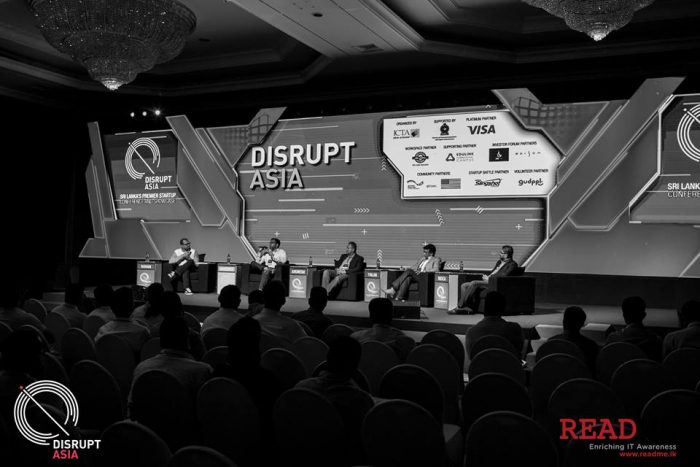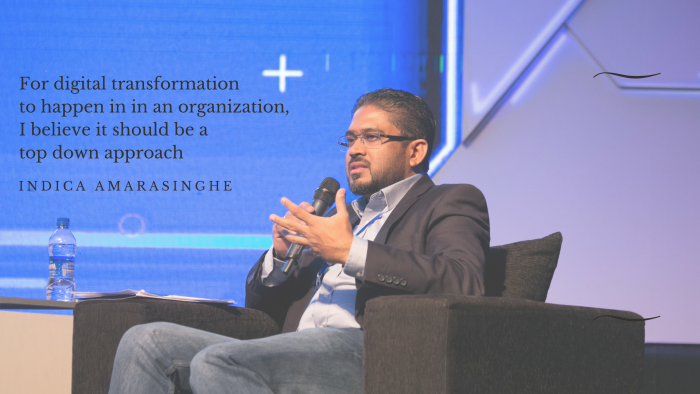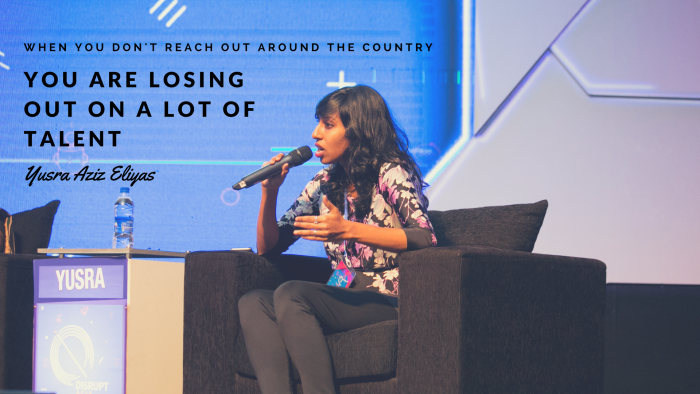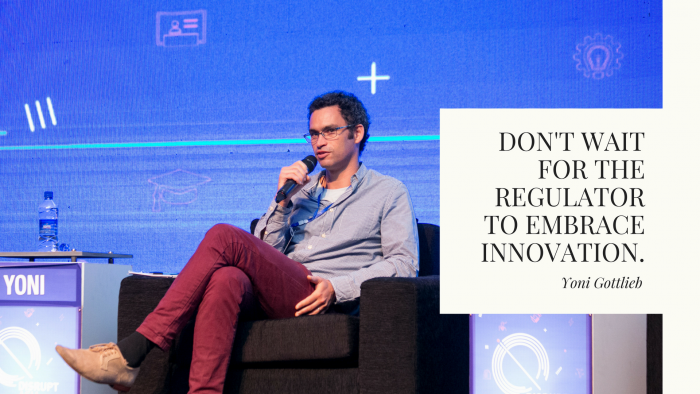It’s the middle of the week and we like hundreds of others made our way to the Hilton Colombo. As we walk inside, we see a large hall full of people. In the middle was where the majority of them were. Gathered around the tall tables, they made jokes, small talk, and shared stories with their friends. We like a few others, decided to meet and see what the twenty seven startups at their stalls located on both sides of the hall had to offer. Welcome to Disrupt Asia 2017.
Taking Sri Lankan startups to the next level
“We are at an important crossroads. We are here to decide what happens to Sri Lanka”, were the opening words of Cheryl Edison at Disrupt Asia 2017. Cheryl described herself as an enthusiastic go-to-market strategist and was the morning keynote speaker at the conference. She argued that rather than always saying, “No,” we should now be ready to say, “Yes!” She went on to explain that in this world, there are only two options: to welcome or to resist.

She then spoke about the startup ecosystems in the US and how they are changing the way opportunities emerge. Cheryl then emphasized that English is the language that needs to be used at this moment. In order to be successful in an innovative startup ecosystem, you will have to use business English. Since the beginning of time, we have used goods to trade with each other. One way that we communicate in this one world is through commerce. In order to show gratitude, we use money
Yet entrepreneurs in Sri Lanka face a huge obstacle when it comes to starting a business. They need the ability to move money. Cheryl argued that we need a payment gateway that empowers entrepreneurs to move money at any time and at any place. This is where #letmegetpaid comes into play. Cheryl is investing money into implementing a payment gateway for Sri Lanka. Her goal is that in 10 days, Sri Lanka will have a working payment gateway for entrepreneurs.
Afterward, she shared with us how to avoid being afraid of failure for this fear is a hindrance to innovation. Cheryl shared that it is only when this fear is eliminated that thriving startup ecosystems are born. Thus, we need people who would provide spaces for entrepreneurs. Spaces where they could start businesses and find mentors to guide them. Such people would have to be proud of being there, welcoming and friendly, neighborly and ethnically diverse, and cooperative. Entrepreneurs need maker spaces.
A maker space also needs to be clean, organized, authentic, and spiritual. Rather than have structured environments, Cheryl encourages people to make the place comfortable for innovation. But how do you innovate? According to Cheryl, it starts by setting a goal, exploring ways to make something happen, and then doing what needs to be done to make it happen. Throughout this process, you must empathize, define, ideate, and create a prototype. However, achieving these goals will ask you to invest a lot of time and money for that is the price of innovation.

Anyone who steps forward without expecting compensation is a volunteer for change. Cheryl then moved on to the topic of conferences and events pointing out that they should be celebratory and culturally authentic. But at the same time also self-sustaining. Money she stated, makes good things happen. Each of us she said is responsible for how we use this money. However, if the Sri Lankan startup ecosystem is to grow, then we must break out of the things that made us comfortable in the past.
Afterward, Cheryl returned to the topic of the payment gateway. She argued that rather than finding people who say yes or no, it’s better to find people who are ready to build it. Many business deals are compromises, as such, it’s alright to negotiate. However, to develop the Sri Lankan startup ecosystem, the proper infrastructure is essential. Once a payment gateway is in place, information and services are the next steps. This is followed by makerspaces and more funding being made available to startups. After touching on how to prepare a great pitch deck, Cheryl concluded her session, which marked the end of the morning keynote.
Is Sri Lanka Digital Ready?
With the conclusion of the morning keynote, Disrupt Asia 2017 took on its true form. The parallel sessions were about to begin and the many attendees of the conference began walking out of the main hall to attend their respective sessions. Soon after, the main hall became the place that would host many of the panel discussions that would take place at Disrupt Asia 2017. These panel discussions covered a variety of topics ranging from technical ones to different aspects of the Sri Lankan startup ecosystem.

The first panel discussion on the main stage took on the topic of Sri Lanka and its preparation for the digital future. This panel discussion was moderated by Rohan Jayaweera – COO of Antyra Solutions. Kicking things off, Indica Amarasinghe – a startup mentor & ICT market development specialist, highlighted how Sri Lanka was digital-ready about 20 years ago. The question was, what have we done with it? This question was redirected to Arunesh Peter – Director of Projects at ICTA. In response, Arunesh emphasized the need for a vision that transcends political agenda and the importance of leadership.
But then again, what’s really holding us back in terms of Sri Lanka and its digital future? Thilan Wijesinghe – Chairman of TWCorp (Pvt) Ltd, argued that the typical Sri Lankan mindset is one issue. But a greater area of concern is the mismanagement of Sri Lanka’s own balance sheet. Thilan mentioned how the weak handling of Sri Lanka’s balance sheet prevents the country from moving forward in this aspect. As the discussion continued, the panelists were asked how we would need to look at the next 10 years and how they would like to see the future.

Among the ideas shared, Thilan mentioned how we need to take a second look at our own culture. We need to treat each and every Sri Lankan as an equal and should reach out to the rural communities more effectively. As a message for budding startups in the island, Indica pointed out how we don’t need to reinvent the wheel. You have to be patient and focus on the ton of needs Sri Lanka has at the moment.
Diversity in tech: how well are we doing?
Next on the agenda was another interesting topic of discussion. This session revolved around the topic of the tech industry’s progress in terms of diversity. Kicking things off, Nayeni Fernando – Former Head of IT at the Central Bank, spoke about how a country should develop by utilizing the human resources at its disposal. With this statement, she shared that 51% of the population in Sri Lanka are women. But in terms of employment, the numbers are significantly lower. “So what’s stopping us?”, asked Nayeni.

She went on to mention how men and women have unique attributes. Making use of these unique attributes is something that needs to looked at. But it’s not just gender diversity though. Manique Gunaratne – Vice Chairperson of South Asian Disability Forum highlighted the need for the inclusion of those with disabilities. Sometimes for a person with a disability, IT is everything. This enables them to work in equal capacity. Manique also mentioned how employers think that being disabled is at times a burden. But that’s often not the case. All that’s needed is a change of mindset.
But what about the future generation? Are we sending the correct message to the young female generation to inspire them towards the tech industry? Answering the question at Disrupt Asia 2017, Yusra Aziz Eliyas – Founder of PodiJobs pointed out that we first need to talk about tech and introduce them to what’s available. According to Yusra, this is a key step towards taking the right approach in sending the correct message out to the young female generation.

Adding on to the discussion, Hiranya Fernando from Careerly mentioned out how it’s pointless to have the men versus women mindset. According to Hiranya, seeing things from a business perspective rather than a gender perspective helps the case in encouraging diversity in the industry.
Innovation In FinTech
FinTech or financial technology is not exactly something new. However, it has certainly become a hot topic in recent times. But what is FinTech exactly? According to Abhijeet Ramesh – Senior Director & Head of Digital Solutions for India and South Asia at Visa, FinTech is a way of simplifying and driving commerce. In modern times, Abhijeet mentioned how tools like social media have become a key driver for consumer engagement with regards to FinTech.
In the local context, digitization plays a key role in the FinTech sector. But when it comes to digitization there’s much more that needs to happen. Among a few of these, Harsha Wanigatunga – Deputy General Manager & Project Director at LankaClear, emphasized the need for the Central Bank to play a more active role in the digitization process. He added that the processes should ideally be made more secure and cheap for Sri Lankans.

But the responsibility doesn’t merely belong to government authorities either. The private sector has to play an active role as well. Even tech giants like Apple and Google have made investments in the banking sector through Apple Pay and Google Pay. So how does the banking industry take up digitization for the future? According to Yoni Gottlieb, trust plays a key role. But trust is often a tricky thing when it comes to banking. So how do you overcome this threat? Embrace innovation.
To be continued
With the conclusion of the third panel discussion, the first set of panel discussions inside the main hall came to an end. Following lunch, we saw another set of informative panel discussions, the Hemas Slingshot startup battle, and the closing keynote. Yet, that’s only what happened in the main hall. There’s still so much more that happened at Disrupt Asia 2017, which includes the investor forum, a series of workshops, and more parallel sessions. Stay tuned because there’s a lot more coming your way from Disrupt Asia 2017.






GIPHY App Key not set. Please check settings